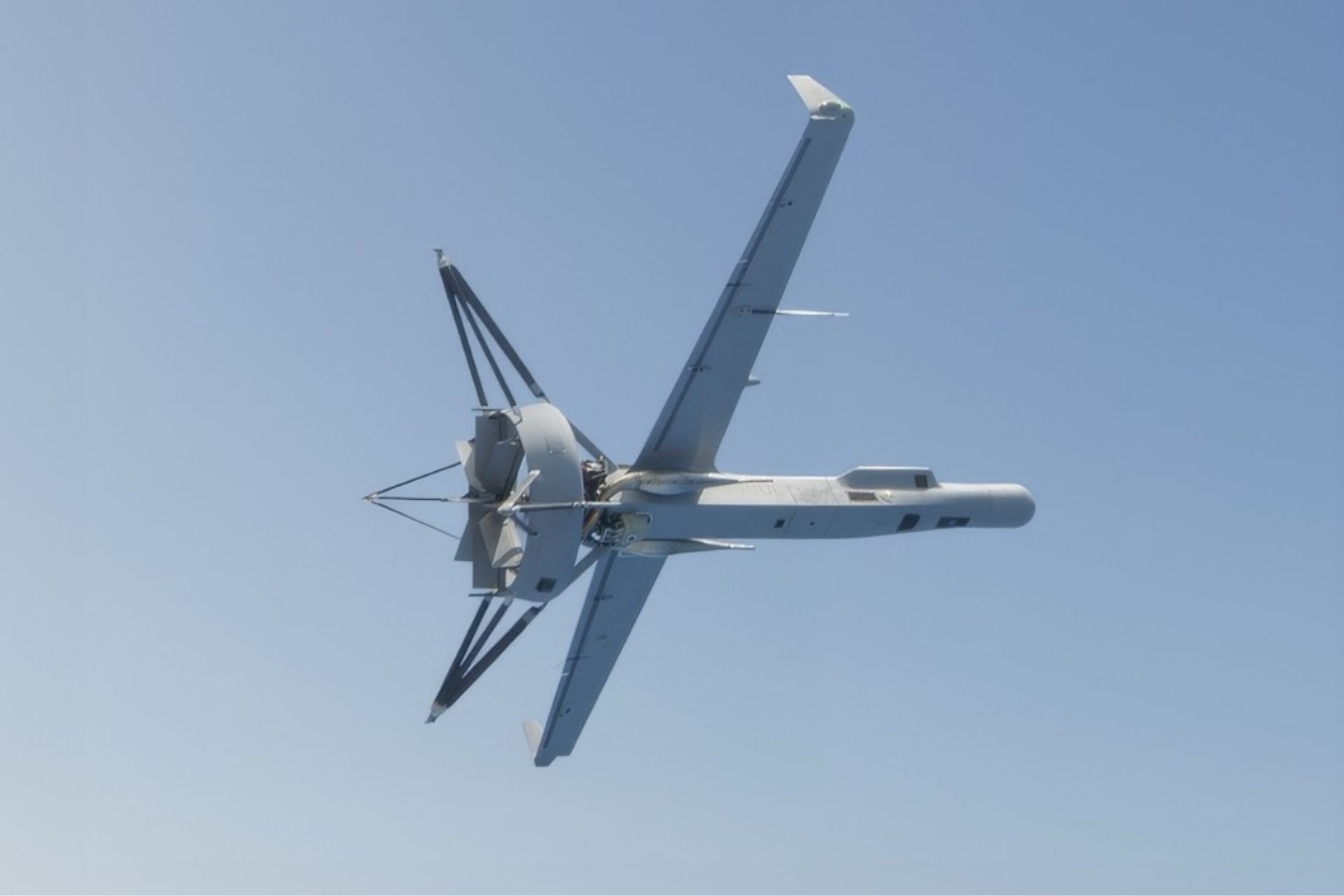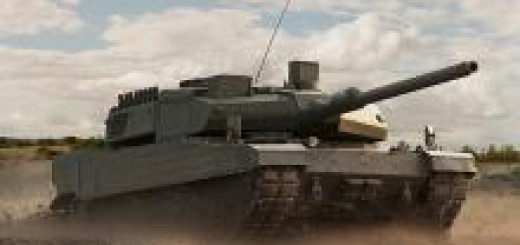New V-BAT drone from Shield AI brings enhanced autonomy and maritime operational capabilities

{loadposition bannertop}
{loadposition sidebarpub}
On April 7, 2025, in Washington, Shield AI, a technology company specializing in autonomy software for defense systems, unveiled a new version of its operationally proven V-BAT drone. This major upgrade delivers capabilities typically associated with Group 4 and 5 UAVs while retaining the compact form factor of a Group 3 system. Designed to address the most demanding challenges faced by U.S. and allied forces, the new V-BAT is positioned as a key asset for missions in GPS- and communications-denied environments, as well as for persistent maritime surveillance and border security operations.
Follow Army Recognition on Google News at this link
The system is now fully compatible with Shield AI’s Hivemind Pilot autonomy software, which enables operators to benefit from AI-powered perception and decision-making (Picture source: Shield AI )
According to Brandon Tseng, President and Co-founder of Shield AI and a former Navy SEAL, modern armed forces are increasingly adopting platforms like the V-BAT to replace larger, more vulnerable, and costly ISR aircraft. This shift toward smaller, more affordable, yet equally capable systems allows forces to conduct similar missions with increased flexibility. The V-BAT is built to operate across the full spectrum of drone missions, from deep-penetration intelligence, surveillance, and reconnaissance (ISR) and targeting in denied environments, to domestic security, search and rescue, and counter-narcotics operations.
Among the key technical upgrades, the latest V-BAT now features a heavy-fuel engine optimized for JP-5, the standard aviation fuel used by naval forces. This configuration extends its endurance to over 13 hours and ensures optimal compatibility with naval and expeditionary missions. The drone retains its unique vertical take-off and landing (VTOL) capability without the need for human assistance, runways, catapults, or recovery equipment. Its patented ducted fan design enables precise and safe landings, even on moving platforms, in confined areas, or in adverse weather conditions.
These features make the V-BAT a suitable solution for expeditionary and maritime forces. It is currently deployed across nearly all classes of U.S. Navy ships and operates with all seven Marine Expeditionary Units (MEUs). The U.S. Coast Guard has selected it for a significant ISR operations contract, and the Japan Maritime Self-Defense Force (JMSDF) has adopted it as its first shipborne ISR platform.
The system is now fully compatible with Shield AI’s Hivemind Pilot autonomy software, which enables operators to benefit from AI-powered perception and decision-making. SATCOM integration ensures Beyond-Line-of-Sight (BLOS) command and control, allowing remote operation from anywhere in the world. V-BAT supports a range of payloads, including ViDAR for passive wide-area motion imagery, synthetic aperture radar (SAR), and electronic warfare systems, enhancing its operational adaptability across multiple domains.
Beyond its technical features, the V-BAT’s operational relevance lies in its ability to address the evolving nature of modern conflicts. In an era where adversaries deploy anti-access/area denial (A2/AD) systems and increasingly rely on GPS jamming and electronic warfare, armed forces require agile, resilient, and infrastructure-independent ISR platforms. With its fully autonomous VTOL capability, the V-BAT can be rapidly deployed from improvised bases, ships, or urban environments, offering immediate ISR coverage in contested or degraded areas.
Its extended endurance and naval fuel compatibility allow it to monitor targets over long distances in maritime environments without imposing additional logistical burdens. Combined with AI-guided autonomy and advanced sensors, the V-BAT provides a reliable tool for detecting hostile activities, tracking troop or vessel movements, mapping landing zones, or conducting surveillance along difficult-to-access borders. It also enables special operations units or forward-deployed forces to maintain persistent aerial awareness without relying on manned aircraft or satellites.
At the Sea-Air-Space Expo, held this week in National Harbor, Maryland, and organized by the U.S. Navy League, Shield AI is showcasing a special edition of the V-BAT in U.S. Coast Guard livery at booth #1101. The event provides a platform for presenting the company’s latest developments in autonomous aerial systems for naval operations.
With this new generation of the V-BAT, Shield AI aims to meet current tactical requirements with a modular, autonomous, and expeditionary-compatible solution. By integrating AI-assisted autonomy, naval fuel propulsion, and SATCOM connectivity, the V-BAT continues to position itself as a key ISR platform in complex environments, reflecting a broader shift toward more agile, cost-efficient systems suited to 21st-century hybrid threats.

{loadposition bannertop}
{loadposition sidebarpub}
On April 7, 2025, in Washington, Shield AI, a technology company specializing in autonomy software for defense systems, unveiled a new version of its operationally proven V-BAT drone. This major upgrade delivers capabilities typically associated with Group 4 and 5 UAVs while retaining the compact form factor of a Group 3 system. Designed to address the most demanding challenges faced by U.S. and allied forces, the new V-BAT is positioned as a key asset for missions in GPS- and communications-denied environments, as well as for persistent maritime surveillance and border security operations.
The system is now fully compatible with Shield AI’s Hivemind Pilot autonomy software, which enables operators to benefit from AI-powered perception and decision-making (Picture source: Shield AI )
According to Brandon Tseng, President and Co-founder of Shield AI and a former Navy SEAL, modern armed forces are increasingly adopting platforms like the V-BAT to replace larger, more vulnerable, and costly ISR aircraft. This shift toward smaller, more affordable, yet equally capable systems allows forces to conduct similar missions with increased flexibility. The V-BAT is built to operate across the full spectrum of drone missions, from deep-penetration intelligence, surveillance, and reconnaissance (ISR) and targeting in denied environments, to domestic security, search and rescue, and counter-narcotics operations.
Among the key technical upgrades, the latest V-BAT now features a heavy-fuel engine optimized for JP-5, the standard aviation fuel used by naval forces. This configuration extends its endurance to over 13 hours and ensures optimal compatibility with naval and expeditionary missions. The drone retains its unique vertical take-off and landing (VTOL) capability without the need for human assistance, runways, catapults, or recovery equipment. Its patented ducted fan design enables precise and safe landings, even on moving platforms, in confined areas, or in adverse weather conditions.
These features make the V-BAT a suitable solution for expeditionary and maritime forces. It is currently deployed across nearly all classes of U.S. Navy ships and operates with all seven Marine Expeditionary Units (MEUs). The U.S. Coast Guard has selected it for a significant ISR operations contract, and the Japan Maritime Self-Defense Force (JMSDF) has adopted it as its first shipborne ISR platform.
The system is now fully compatible with Shield AI’s Hivemind Pilot autonomy software, which enables operators to benefit from AI-powered perception and decision-making. SATCOM integration ensures Beyond-Line-of-Sight (BLOS) command and control, allowing remote operation from anywhere in the world. V-BAT supports a range of payloads, including ViDAR for passive wide-area motion imagery, synthetic aperture radar (SAR), and electronic warfare systems, enhancing its operational adaptability across multiple domains.
Beyond its technical features, the V-BAT’s operational relevance lies in its ability to address the evolving nature of modern conflicts. In an era where adversaries deploy anti-access/area denial (A2/AD) systems and increasingly rely on GPS jamming and electronic warfare, armed forces require agile, resilient, and infrastructure-independent ISR platforms. With its fully autonomous VTOL capability, the V-BAT can be rapidly deployed from improvised bases, ships, or urban environments, offering immediate ISR coverage in contested or degraded areas.
Its extended endurance and naval fuel compatibility allow it to monitor targets over long distances in maritime environments without imposing additional logistical burdens. Combined with AI-guided autonomy and advanced sensors, the V-BAT provides a reliable tool for detecting hostile activities, tracking troop or vessel movements, mapping landing zones, or conducting surveillance along difficult-to-access borders. It also enables special operations units or forward-deployed forces to maintain persistent aerial awareness without relying on manned aircraft or satellites.
At the Sea-Air-Space Expo, held this week in National Harbor, Maryland, and organized by the U.S. Navy League, Shield AI is showcasing a special edition of the V-BAT in U.S. Coast Guard livery at booth #1101. The event provides a platform for presenting the company’s latest developments in autonomous aerial systems for naval operations.
With this new generation of the V-BAT, Shield AI aims to meet current tactical requirements with a modular, autonomous, and expeditionary-compatible solution. By integrating AI-assisted autonomy, naval fuel propulsion, and SATCOM connectivity, the V-BAT continues to position itself as a key ISR platform in complex environments, reflecting a broader shift toward more agile, cost-efficient systems suited to 21st-century hybrid threats.





